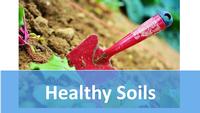Soils for Ranchers & Natural Resource Managers
Tips to build your rangeland and pasture and forest Soil
|

|
What's the difference between rangeland and Pasture?
Common rangeland and pasture soil problems
How do I improve my soilPractices to improve your soil Rangelands
Pastures
Resources |
What's the difference between rangeland and pasture?

|
Rangelandis land with natural vegetation predominantly grasses, grass-like plants, forbs or shrubs that may be grazed by domestic livestock. Rangeland can be open grasslands or in forested areas. |

|
Pastureis grazing land with seeded plants for improved forage. Management of pastures will include grazing management, cultivation, seeding, fertilization, irrigation and pest management. It may also include mowing and reseeding. |
Common rangeland and pasture Soil problems
Leads Sheila Barry and Theresa Becchetti

|
Common rangeland and pasture soil problemsRangelands face problems of 1) maintaining soils for productivity, 2) management of noxious weeds (though not really soil related), 3) appropriate soil management to meet ecosystem goals (e.g., vernal pool or habitat maintenance), and 4) point erosion around roads. Pastures have challenges around 1) irrigation and 2) fertilization (N and sometimes P if growing legumes) to maintain grass growth for productivity. There is increasing concern the the increasing lose of ground cover due to fires is leading to increases in 1) water erosion and 2) mudslides. (We are seeking confirmation of this.) You can check your soil type at Soil web (T O’Geen) to get a general sense of soils in your area. Soil web is a remarkable map resource showing soil types throughout California with detailed information on soil characteristics and potential uses. |
How do I improve my soil

|
OpportunitiesSequester C as a marketing opportunity (i.e., Potentially gain a cost premium by marketing as "Products come from lands actively seeking to help preserve our planet" or similar.) Low maintenance roads to limit site erosion. Reduce erosion by 1) Protecting your soil surface and 2) Avoiding water channeling and concentrating Practices to improve soil healthRangelands
Pastures
|
Practices to improve your soil
Rangelands
Rangelands cover approximately 60% of California or 57 million acres. California’s low elevation rangelands are typically dominated by non-native annual plants that are adapted to the Mediterranean climate.
Despite the dominance of non-native plants, California’s annual rangelands provide habitat for a large diversity of native plants and annuals including as many as 200 federally listed species.
Rangeland management typically involves grazing management, water development, pest management, and road maintenance.
|
Building rangeland soil health
|
Sequestering Carbon
Graze for soil health
Grazing - why, what, when, how Yes, grazing is key to a healthy soil and rangeland health. Hundreds of years ago, this balance was kept through buffalo, deer and elk and now often by cattle. Recommended Grazing practices: Understand grazing Fact Sheet (Barry, Larson, Ford and Bush) Stocking rates: Rangeland productivity Fact Sheet (Becchetti) Alfalfa - Find information on alfala management practices (Agronomy RIC) Compost (fertilize)
The use of regular inorganic fertilizer is rarely economic on rangelands. Assess compost quality for Agriculture Fact Sheet What's in the different products? Fact sheet Compost for Rangelands Fact Sheet Seeding (rangeland)See Seeding Part 1: Sow, You Want to Seed Your Rangeland or Irrigated Pasture Preserve, rehabilitate and diversify Habitat - Riparian areasWhat's the goal (e.g., birds, vernal pools)? Visual assessment of Riparian Health Fact Sheet Establishing Hedgerows in California Fact sheet WaterCows need water too Fact sheet (Barry, Larson, Bush) Building roadsHow do I establish roads for minimal cost while limiting erosion? Fact Sheet Why should I care if I lose a bit of soil? Erosion is important for two main reasons
|
Pastures
|
Building pasture soil health
|
Pastures - managed forage for livestock
Sequestering Carbon
Why and how do I sequester Carbon? Fact Sheet Irrigation
Managing irrigated pasture during drought Fact sheet FertilizationAssessing compost quality for Agriculture Fact Sheet What's in the different products? Fact sheet GrazingGraze! Yes, grazing (hundreds of years ago by buffalo, deer and elk) and now often by cattle is key to a healthy pasture. Recommended Grazing practices? Understand grazing Fact Sheet (Barry, Larson, Ford and Bush) Seeding (pastures)See Seeding Part 1: Sow, You Want to Seed Your Rangeland or Irrigated Pasture Riparian areasVisual assessment of Riparian Health Fact Sheet Establishing Hedgerows in California Fact sheet RoadsHow do I establish roads for minimal cost while limiting erosion? Fact Sheet |
Soil rehabilitation (post mining/ disruption) |
Protect the soil surface and control (channel) runoff |
Resources: For more on Rangelands
- Research & Information Center
- UC Rangelands (web)
- California Institute for Water Resources (web)
- Rangeland Watershed Laboratory (web)
- Clear Lake Aquatic Website (web)

